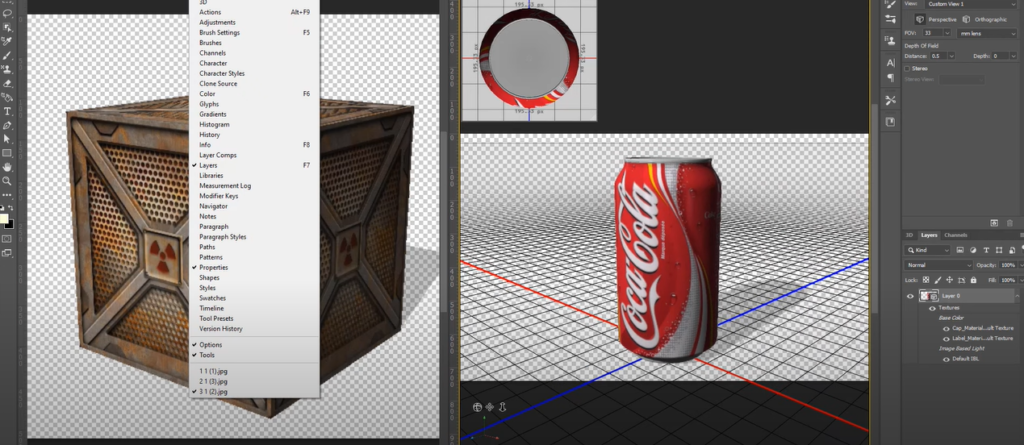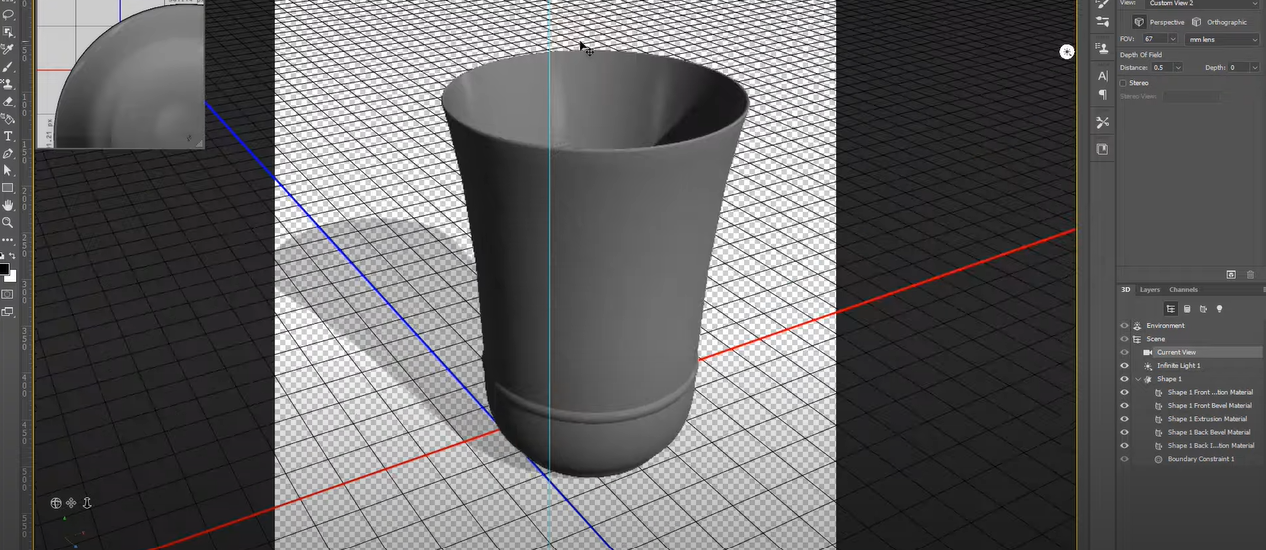Adobe Photoshop is predominantly known for its remarkable photo-editing capabilities. But, unknown to many, this robust software extends beyond image manipulation, offering comprehensive 3D modeling features. This article will explore the capabilities and application of Photoshop in 3D modeling.
The Photoshop 3D Interface
Step into the captivating world of three-dimensional design with Photoshop’s mesmerizing 3D interface. Be prepared to be spellbound by the myriad of possibilities it offers, where your creative visions can take shape and transcend the boundaries of two-dimensional art. Journey through the five enchanting sections of the 3D panel, each holding the key to unlocking the secrets of your imagination.
The Enchanted Scene Section
In this ethereal realm, the Scene section reigns supreme. Here, you wield the power to control the very essence of your 3D creation. Embrace the autonomy to modify the scene’s properties, tweak its global settings, and orchestrate a symphony of visuals in perfect harmony. This mystical realm holds the foundation upon which your entire 3D world shall be built.
The Mesmerizing Meshes Section
Venture into the heart of the 3D realm, where the Meshes section lies in all its splendor. Here, you shall be granted the ability to handpick, manipulate, and unleash your creativity upon individual 3D objects. With your magic wand (or mouse), shape and mold these objects to your heart’s desire, and watch as they come to life in the magical world of three dimensions.
The Bewitching Materials Section
Behold the captivating allure of the Materials section, where you can invoke the powers of transformation upon your 3D creations. This mystical chamber enables you to change the very essence of objects, imbuing them with mesmerizing colors, brilliant shine, and textures that whisper tales of far-off lands. Allow your designs to transcend the ordinary and become enchanted works of art.
The Radiant Lights Section
As you delve deeper into the 3D interface, you’ll encounter the Radiant Lights section, shimmering with luminous potential. With the flick of your wand (or a few clicks), you can add, adjust, and manage the luminous beings that illuminate your 3D realm. Bring forth the dawn of dazzling suns or bask in the glow of mystical moonlight – the choice is yours to make.
The Spellbinding Animation Section
Lastly, brace yourself for the enchanting finale – the Animation section, where static 3D objects come alive through bewitching movement and lifelike gestures. With this magic at your disposal, breathe life into your creations, and watch as they dance, twirl, and weave their tales of wonder, captivating the beholders and leaving them mesmerized.
Building 3D Objects in Photoshop

Creating 3D objects in Photoshop involves several steps, from creating an initial shape to refining your 3D object:
Step 1
Forging the 3D Object In this pivotal stage, you’ll discover two mystical methods to forge your 3D object. The first method involves the arcane art of converting a 2D layer into a magnificent 3D entity, infusing it with depth and dimension. Alternatively, the second method offers a shortcut through a hidden passage, where you’ll unearth preset 3D shapes, ready to be summoned into existence. Whichever path you choose, the realm of possibilities will open wide before you.
Methods for Creating 3D Objects in Photoshop
| Method | Description |
|---|---|
| Convert 2D to 3D | Transform a 2D layer into a wondrous 3D object with depth. |
| Preset 3D Shapes | Summon pre-made 3D shapes from the mystical depths of Photoshop. |
Step 2
Enchanting Manipulation Once your 3D object takes shape, the properties panel becomes your sorcerer’s toolkit, granting you the power to manipulate every aspect of your creation. Delve into this enchanting panel to alter the object’s dimensions, bestowing it with the exact proportions your imagination desires. Unleash the magic of textures, enveloping your 3D wonder in a cloak of brilliance, transcending the ordinary with every stroke. Harness the elusive art of lighting, casting radiant glows or mysterious shadows upon your creation, accentuating its allure. And should your heart desire to breathe life into your masterpiece, the panel allows you to add bewitching animations, making your 3D object dance with delight.
Manipulation Options in the Properties Panel
| Manipulation | Description |
|---|---|
| Change Dimensions | Alter the size and scale of your 3D object. |
| Add Textures | Apply captivating textures to imbue your object with charm. |
| Adjust Lighting | Play with lights to illuminate or mystify your creation. |
| Add Animations | Bring your creation to life with enchanting animations. |
Step 3
Conjure the Final Masterpiece – Rendering As you reach the culmination of your artistic odyssey, it’s time to render your 3D model. In this spellbinding act, all your adjustments and magical touches coalesce into a breathtaking final image or animation. With a mere incantation, Photoshop weaves together the threads of your creation, presenting your 3D object in all its magnificence to the world.
Practical Applications of Photoshop 3D Modeling
Photoshop’s 3D modeling has numerous applications across various fields. Here are a few:
Graphic Design
Illuminating Marketing Materials and Beyond In the realm of graphic design, 3D modeling emerges as the mighty wand that weaves enchanting visuals. Designers wield this magic to create eye-catching marketing materials that mesmerize audiences. From captivating product packaging that leaps off the shelves to spellbinding logos that imprint in memories, 3D modeling elevates branding to new heights. Even the very essence of websites comes to life with graphics that dance and sparkle, leaving visitors captivated.
Applications of 3D Modeling in Graphic Design
| Application | Description |
|---|---|
| Marketing Materials | Craft captivating designs for brochures, posters, and promotional items. |
| Product Packaging | Enchant consumers with striking 3D product packaging designs. |
| Logos | Bestow depth and allure upon logos, making them unforgettable. |
| Website Graphics | Elevate website aesthetics with mesmerizing 3D visuals. |
Architecture and Interior Design
Building Dreams, Brick by Brick The alchemy of 3D modeling breathes life into architectural and interior designs. Designers conjure realistic 3D representations of buildings and spaces, enabling clients to traverse their future havens in virtual realms. Witness the wonder as clients explore their dream homes, offices, or public spaces before construction commences. The process becomes a dance of inspiration and collaboration, allowing designers to refine their visions and create enchanting environments that resonate with hearts and souls.
Applications of 3D Modeling in Architecture and Interior Design
| Application | Description |
|---|---|
| Building Visualization | Offer clients immersive experiences by showcasing 3D architectural designs. |
| Interior Spaces | Present mesmerizing 3D renditions of interiors to inspire and captivate. |
| Material and Texture | Experiment with materials and textures to achieve the perfect ambiance. |
Gaming and Animation
Where Fantasies Come Alive Step into the realm of gaming and animation, where 3D modeling wields its magic on characters, landscapes, and beyond. Aspiring creators craft intricate character models, each detail meticulously sculpted to tell tales of bravery and adventure. The breathtaking landscapes of imaginary worlds emerge from the depths of imagination, enhanced by 3D mastery. Behold the wonder as animations come to life, evoking emotions and weaving unforgettable stories.
Applications of 3D Modeling in Gaming and Animation
| Application | Description |
|---|---|
| Character Models | Bring characters to life with intricate 3D models and lifelike details. |
| Environmental Elements | Create awe-inspiring landscapes and settings for immersive experiences. |
| Animations | Use 3D modeling to craft captivating animations that enchant viewers. |
Fashion and Apparel Design
From Concept to Runway In the realm of fashion and apparel design, 3D modeling casts a spell on the creative process. Designers enchant their sketches into 3D mockups, allowing them to visualize the flow and form of fabrics and garments. Virtual runways become their canvas, where they experiment with styles and cuts, bringing their artistic visions to life. With 3D modeling, designers weave magic through their work, transforming fashion dreams into wearable realities.
Applications of 3D Modeling in Fashion and Apparel Design
| Application | Description |
|---|---|
| 3D Mockups | Transform 2D sketches into realistic 3D mockups for previewing. |
| Virtual Runways | Experiment with designs and styles on virtual runways for display. |
| Fabric and Material | Visualize fabrics and materials on 3D models for accurate previews. |
For a better understanding of the Photoshop 3D modeling process, check out this video:
Common Mistakes and Solutions

Like any software, Photoshop 3D modeling may present some challenges. Here are a few common mistakes and their solutions:
- Rendering Issues: These can occur due to high resolution and complexity of the 3D model. Lowering the resolution can help alleviate this problem;
- Poor Lighting: Lighting affects the perception of your 3D model. Experiment with different light sources to achieve the desired effect;
- Texture Misalignment: This can occur when wrapping 2D textures around 3D objects. Use the Properties panel to adjust the texture.
Conclusion
Photoshop’s 3D modeling capabilities offer a range of possibilities. Whether you’re a graphic designer or an architect, understanding and utilizing these features can significantly improve your work. While it may not replace specialized 3D software, Photoshop is a powerful tool to create, manipulate, and render 3D models.
FAQ
Yes, Photoshop offers basic to intermediate 3D modeling capabilities suitable for various professional applications, from graphic design to architecture. However, for more complex projects, specialized 3D modeling software might be more appropriate.
Yes, Photoshop supports 3D printing. You can create, refine, and print 3D models directly from Photoshop. The software even checks your model for potential print issues and provides solutions.
Improving the rendering speed can be achieved by reducing the resolution of the 3D model, turning off the shadows or reflections, or using a computer with better hardware specifications.
While having drawing skills can be beneficial in visualizing and planning your 3D model, it’s not a necessity. Photoshop provides intuitive tools and pre-made shapes to help create 3D models.
Yes, Photoshop provides basic animation capabilities. You can create simple animations, such as rotation and position change. For more complex animations, specialized software is recommended.
